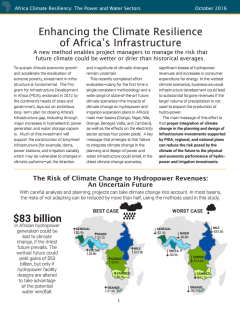
To sustain Africa’s economic growth and accelerate the eradication of extreme poverty, investment in infrastructure is fundamental. The Program for Infrastructure Development in Africa (PIDA), endorsed in 2012 by the continent’s heads of state and government, lays out an ambitious long- term plan for closing Africa’s infrastructure gap, including through major increases in hydroelectric power generation and water storage capacity. Much of this investment will support the construction of long-lived infrastructure (for example, dams, power stations, and irrigation canals), which may be vulnerable to changes in climatic patterns—yet the direction and magnitude of climatic changes remain uncertain. This recently completed effort evaluates—using for the first time a single consistent methodology and a wide range of state-of-the-art future climate scenarios—the impacts of climate change on hydropower and irrigation expansion plans in Africa’s main river basins (Congo, Niger, Nile, Orange, Senegal, Volta, and Zambezi), as well as the effects on the electricity sector across four power pools.
A key message that emerges is that failure to integrate climate change in the planning and design of power and water infrastructure could entail, in the driest climate change scenarios, significant losses of hydropower revenues and increases in consumer expenditure for energy. In the wettest climate scenarios, business-as-usual infrastructure development could lead to substantial forgone revenues if the larger volume of precipitation is not used to expand the production of hydro-power. The main message of this effort is that proper integration of climate change in the planning and design of infrastructure investments supported by PIDA, regional, and national plans can reduce the risk posed by the climate of the future to the physical and economic performance of hydropower and irrigation investments.
